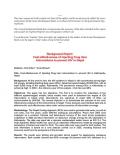What's New
Displaying results 4401 - 4410 of 4914

Resource | Tools,
National AIDS programmes have become increasingly complex over the past ten years and the role of the programme manager has expanded to accommodate this complexity. The complexity of this role varies from country to country, and is somewhat easier in countries with larger AIDS programmes, in which roles are distributed across a multidisciplinary team.

Resource | Tools,
This module outlines some of the systems that can support the efficient management of a national AIDS programme. These include human resource management, financial management, commodity management and information management.

Resource | Tools,
This module covers the elements of strategic information necessary for developing a clear understanding of the exact nature of the AIDS epidemic and the response to the epidemic in a particular place: the surveillance systems that provide information on HIV prevalence and changing patterns of risk and vulnerability; the monitoring and evaluation framework that provides information about the process, outcome and impact of the interventions; and the strategic research agenda that can fill in gaps in information and provide guidance for reviewing interventions and strategies.

Resource | Tools,
The training modules on National AIDS Programme Management were developed by the WHO Global Programme on AIDS in the early 1990s to assist AIDS country programme managers at national and subnational levels in developing their capacity to manage the complex range of programmes and activities under their responsibility. Intercountry training courses using those modules were conducted by the WHO Regional Office for South-East Asia, followed by training at the national level during the 1990s. Those courses resulted in the development of the skills of many senior staff in the Region – and many of them are still playing critical roles as national programme mangers or senior policy-makers today.

Resource | Publications,
This report presents the new HIV estimations and its demographic impact analysis based in a workshop that reviewed the data available from the previous HIV estimation workshop, which was held in September 2005 and HIV data for the years 2005 and 2006. The initial discussions were based in the draft estimates produced during the estimates training held in Bangkok in April 2007.

Resource | Publications,
At this point in time, the HIV epidemic in Nepal is still concentrated among high-risk groups, including injecting drug users (IDUs). Nepal has approximately 20,000 IDUs, with at least 5,000 living in the capital, Kathmandu. HIV prevalence among IDUs in Kathmandu is extremely high. In 2003 – the reference year of this analysis – that rate was 68%.
This paper has two objectives. The first is to examine the robustness of two different epidemiological models; these models were used to determine the impact of IDU interventions in Nepal when interventions are scaled-up to reach 60% of IDUs, as recommended by UNAIDS. The second objective is to disseminate the outcome of two cost- effectiveness analyses of IDU interventions in Nepal. These analyses used identical data sets to determine the cost-effectiveness ratios under various scenarios of intervention coverage.
Nepal has been selected as a case study for two reasons. Firstly, it has good quality cost data information that is easily converted into 2003 prices, and behavioural surveillance data from 2003. Secondly, Nepal was one of four countries in the region where an alpha version of the Asian Effectiveness Model (AEM) (Brown and Peerapatanapokin 2004, Brown T 2005) was available at the time of the analysis (June/July 2007).

Resource | Publications,
FHI/Vietnam shared results from the female sex workers (FSWs) rapid interviews at a workshop for provincial project staff, health educators, peer educators, drop-in center managers, and partner project managers. The aims of the workshop were to review current status of programming and to develop new approaches to overcome barriers to female sex workers (FSWs) risk behaviors.

Resource | Publications,
The global epidemic of human immunodeficiency virus (HIV) has radically challenged efforts at tuberculosis control and treatment. Tuberculosis is a leading cause of death among HIV patients, with recent reports indicating that between 27 and 80% of tuberculosis patients are coinfected in a variety of settings with measurable prevalence of HIV.
HIV prevalence among tuberculosis patients in Afghanistan is currently quite low. However, lack of knowledge of HIV and engaging in high-risk practices, particularly regarding health, make this group vulnerable. Health education sessions regarding HIV, sexually transmitted infection, and blood-borne infections should be implemented for tuberculosis patients during the treatment course.

Resource | Fact Sheets,
The survey aimed to improve the understanding the situation of HIV and sexually transmitted infections in female sex workers. The result would help a better prevention programme planning in Hong Kong.
The survey was conducted between 6 November 2006 and 31 January 2007. Five participating NGO outreached to their familiar settings and conducted interviews with female sex workers.

Resource | Publications,
The Bangladesh Bureau of Statistics has been conducting the Multiple Indicator Cluster Survey since 1993 with the technical support of UNICEF. MICS 2006 was conducted during June through October 2006. The MICS 2006 is the ninth survey conducted in Bangladesh. This final report is based on the MICS 2006. A key findings report was published in June 2007.
The Bangladesh Bureau of Statistics conducted the Multiple Indicator Cluster Survey (MICS) between June and October 2006. The main objective of the survey was to provide up-to-date information for assessing the situation of children and women in Bangladesh. The survey also aimed at furnishing data needed for monitoring progress towards goals established by the MDGs, the goals of A World Fit For Children, and other internationally agreed upon goals, as a basis for future action; as well as contributing to the improvement of data and monitoring systems in Bangladesh and strengthening technical expertise in the design, implementation, and analysis of such systems.





